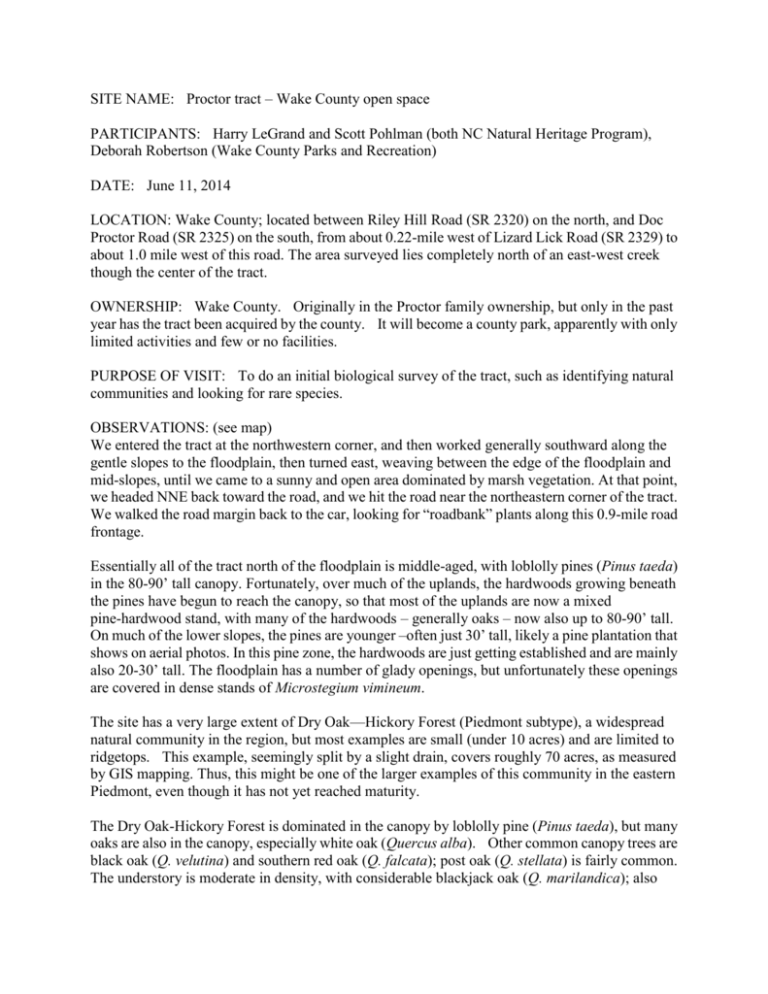Proctor tract -- Wake County open space
advertisement

SITE NAME: Proctor tract – Wake County open space PARTICIPANTS: Harry LeGrand and Scott Pohlman (both NC Natural Heritage Program), Deborah Robertson (Wake County Parks and Recreation) DATE: June 11, 2014 LOCATION: Wake County; located between Riley Hill Road (SR 2320) on the north, and Doc Proctor Road (SR 2325) on the south, from about 0.22-mile west of Lizard Lick Road (SR 2329) to about 1.0 mile west of this road. The area surveyed lies completely north of an east-west creek though the center of the tract. OWNERSHIP: Wake County. Originally in the Proctor family ownership, but only in the past year has the tract been acquired by the county. It will become a county park, apparently with only limited activities and few or no facilities. PURPOSE OF VISIT: To do an initial biological survey of the tract, such as identifying natural communities and looking for rare species. OBSERVATIONS: (see map) We entered the tract at the northwestern corner, and then worked generally southward along the gentle slopes to the floodplain, then turned east, weaving between the edge of the floodplain and mid-slopes, until we came to a sunny and open area dominated by marsh vegetation. At that point, we headed NNE back toward the road, and we hit the road near the northeastern corner of the tract. We walked the road margin back to the car, looking for “roadbank” plants along this 0.9-mile road frontage. Essentially all of the tract north of the floodplain is middle-aged, with loblolly pines (Pinus taeda) in the 80-90’ tall canopy. Fortunately, over much of the uplands, the hardwoods growing beneath the pines have begun to reach the canopy, so that most of the uplands are now a mixed pine-hardwood stand, with many of the hardwoods – generally oaks – now also up to 80-90’ tall. On much of the lower slopes, the pines are younger –often just 30’ tall, likely a pine plantation that shows on aerial photos. In this pine zone, the hardwoods are just getting established and are mainly also 20-30’ tall. The floodplain has a number of glady openings, but unfortunately these openings are covered in dense stands of Microstegium vimineum. The site has a very large extent of Dry Oak—Hickory Forest (Piedmont subtype), a widespread natural community in the region, but most examples are small (under 10 acres) and are limited to ridgetops. This example, seemingly split by a slight drain, covers roughly 70 acres, as measured by GIS mapping. Thus, this might be one of the larger examples of this community in the eastern Piedmont, even though it has not yet reached maturity. The Dry Oak-Hickory Forest is dominated in the canopy by loblolly pine (Pinus taeda), but many oaks are also in the canopy, especially white oak (Quercus alba). Other common canopy trees are black oak (Q. velutina) and southern red oak (Q. falcata); post oak (Q. stellata) is fairly common. The understory is moderate in density, with considerable blackjack oak (Q. marilandica); also numerous are sourwood (Oxydendrum arboreum), and black gum (Nyssa sylvatica). The tall shrub zone is sparse, and one can see many dozens of yards through the forest. This might be normal for this community, as opposed to deer browse. However, locally dense patches of low shrubs are present, mainly ericads such as early lowbush blueberry (Vaccinum pallidum) and dangleberry (Gaylussacia frondosa). Despite the layer not being dense in most areas, there is a fairly high diversity of shrubs in the community. The herb layer, however, is lacking in many areas, and are mainly various grasses, with very few forbs present. There is a slight seepage area along one of the westernmost draws, and this area – despite being under a canopy of young loblolly pines, has several Coastal Plain species. This is a poor example of Piedmont Boggy Streamhead natural community. Notable species there are sweetbay (Magnolia virginiana), titi (Cyrilla racemiflora), bamboo-vine (Smilax laurifolia), and waxmyrtle (Myrica cerifera). Other characteristic species of this small community are wild raisin (Viburnum nudum), winterberry (Ilex verticillata), giant cane (Arundinaria gigantea), and cinnamon fern (Osmunda cinnamomea). The wetland along the creek had little of interest, though near the eastern end the area is open and sunny, with heavy mud depositions, perhaps the remant of a beaver pond that is filling in. Cattail (Typha latifolia) is present. This area needs further survey work, especially to see if a pond is present. The other notable feature is the long stretch of dry roadbanks along Riley Hill Road. This area has a moderate diversity of herbs and shrubs, and large areas are covered in various blueberries, such as small black blueberry (V. tenellum) and deerberry (V. stamineum). Of most significance is a large population of the globally uncommon sandhill St. John’s-wort (Hypericum lloydii). This subshrub is present in the hundreds, and might be one of the larger populations anywhere. PLANTS NOTED: DOH = Dry Oak—Hickory Forest PBS = Piedmont Boggy Streamhead F = Floodplain RB = roadbank Canopy Acer rubrum Carya glabra Carya pallida Carya tomentosa Juglans nigra Liquidambar styraciflua Liriodendron tulipifera Pinus echinata Pinus taeda Quercus alba Quercus falcata DOH, F DOH DOH DOH RB DOH DOH, F DOH DOH, PBS DOH DOH common in wetlands, numerous in uplands numerous; most common of the hickories a few seen; locally uncommon in region not common, and mostly not mature yet only one seen, a sapling on the roadbank not numerous, and no large trees seen scattered, few truly mature ones only 1-2 seen, but mature dominant dominant hardwood species numerous Quercus michauxii Quercus stellata Quercus velutina Ulmus americana W DOH DOH W scattered, with a few mature trees present scattered common only a few Understory Amelanchier sp. Aralia spinosa Carpinus caroliniana Cornus florida Cyrilla racemiflora Diospyros virginiana Fraxinus americana Ilex opaca Juniperus virginiana Magnolia virginiana Morus rubra Myrica cerifera Nyssa sylvatica Oxydendrum arboreum Prunus serotina Quercus marilandica Quercus nigra Quercus phellos Sassafras albidum Ulmus alata RB RB PBS, W DOH PBS DOH DOH, PBS DOH DOH PBS DOH PBS DOH DOH DOH DOH DOH DOH, W DOH, RB DOH one sapling at edge of woods; probably A. arborea a few seedlings numerous rather common, but few mature ones yet a few small trees; locally rare in region common, mostly saplings a few saplings; no tree-sized ones seen fairly common scattered scattered; a few to 30’ tall; locally scarce only 1-2 a few common common scattered small trees not uncommon scattered; very few mature trees yet scattered seedlings; mature trees not seen scattered, mainly on road bank only a few; surprisingly scarce Shrub Layer Alnus serrulata Arundinaria gigantea Asimina parviflora Baccharis halimifolia Callicarpa americana Corylus americana Euonymusa americanus Gaylussacia frondosa Hypericum hypericoides Hypericum lloydii Ilex decidua Ilex verticillata Lyonia mariana Rhus copallina Rosa carolina Rubus cuneifolius Rubus sp. Sorbus arbutifolia PBS, W a few PBS, W moderate stand in one seep area DOH a few RB one seedling seen DOH scattered PBS, W a few DOH a few DOH, PBS a handful of large and dense stands DOH a few RB common; hundreds, in early bud; locally scarce DOH only a few seen DOH, PBS, W scattered, mainly in seeps DOH, RB scattered DOH, RB scattered, mainly on road bank DOH a few RB a few RB a few PBS 1-2 seen Vaccinium arboreum Vaccinium atrococcum Vaccinium tenellum Vaccinium pallidum Vaccinium stamineum Viburnum dentatum Viburnum nudum Viburnum prunifolium DOH, RB DOH DOH, RB DOH, RB RB PBS, W PBS DOH only a few; not as many as expected fairly common numerous, and very common on bank common in woods and on bank locally common; not seen in forest scattered scattered seedlings only only one seen Vines Bignonia capreloata Campsis radicans Clitoria mariana Dioscorea villosa Gelsemium sempervirens Mikania scandens Parthenocissus quinquefolius Smilax laurifolia Smilax rotundifolia Toxicodendron radicans Trachelospermum difforme Vitis rotundifolia W only 1 vine seen DOH, W scattered DOH, RB scattered DOH, PBS, W scattered DOH scattered W one seen DOH scattered PBS a few; locally rare in Piedmont DOH, PBS, W abundant in lower portions of the tract DOH, F, RB abundant locally on bank; infrequent elsewhere DOH, PBS, W scattered DOH, RB common Herb Layer Antennaria sp. Asclepias amplexicaulis Asclepias tuberosa Athyrium asplenioides Boehmeria cylindrica Botrychium virginianum Carex intumescens Chasmanthium laxum Chimaphila maculata Cypripedium acaule Danthonia spicata Dichanthelium polyanthes Dichanthelium spp. Elephantopus tomentosus Eupatorium capillifolium Eupatorium hyssopifolium Eupatorium rotundifolium Euphorbia corollata Galium uniflorum Goodyera pubescens Lactuca canadensis Lechea sp. RB RB DOH W PBS, W DOH PBS DOH DOH DOH, RB DOH, RB DOH DOH DOH, RB RB RB RB RB DOH DOH RB RB a few one seen only one plant seen locally common fairly common a few seen in mesic areas a few, in fruit scattered fairly common fairly common, mostly near road scattered scattered scattered common scattered a few a few a few, in bloom a few in mesic areas a few in mesic areas one seen a few Lespedeza intermedia Lycopodium flabelliforme Lycopus sp. Microstegium vimineum Mitchella repens Murdannia nudiflora Osmunda cinnamomea Osmunda regalis Oxalis sp. Parthenium integrifolium Peltandra virginica Penstemon laevigatus Polystichum acrostichoides Potentilla canadensis Pteridium aquilinum Sanicula canadensis Saururus cernuus Scutellaria integrifolia Sericocarpus asteroides Silphium compositum Sisyrinchium sp. Solidago petiolaris Solidago pinetorum Sphagnum sp. Stylosanthes biflora Tephrosia virginiana Thelypteris noveboracensis Typha latifolia Viola sp. Woodwardia areolata Yucca filamentosa DOH, RB scattered PBS one small patch seen W one seen W exotic; locally dominant in some low grounds DOH, PBS locally common W exotic; locally dense in creek margins DOH, PBS, W mainly in seeps W in marsh DOH a few in mesic areas RB scattered; in bloom W scattered in marshes and mud RB a few, in bloom DOH, W a few small stands DOH, RB a few DOH scattered W one seen W common in muddy areas DOH, RB scattered; one of the few species seen in bloom RB fairly common; early bloom RB a few DOH, RB a few RB a few RB numerous PBS one or two patches in seeps RB fairly common, in bloom RB common; in bloom W one stand seen W locally dense in marsh W a few PBS, W several moderate stands RB one seen; native here? ANIMALS NOTED: Mammals White-tailed Deer Raccoon E. Gray Squirrel scat tracks leaf nest Birds Turkey Vulture Black Vulture Red-shouldered Hawk Yellow-billed Cuckoo Downy Woodpecker high overhead high overhead Pileated Woodpecker? Carolina Chickadee Tufted Titmouse Blue Jay American Crow Brown Thrasher Carolina Wren Blue-gray Gnatcatcher White-eyed Vireo Yellow-throated Vireo Red-eyed Vireo Northern Parula Pine Warbler Ovenbird Hooded Warbler Common Yellowthroat Summer Tanager Northern Cardinal Eastern Towhee Blue Grosbeak Indigo Bunting Brown-headed Cowbird Common Grackle Herps Spring Peeper Northern Cricket Frog Green Frog very low, loud drumming heard overhead only one heard 3-4 singing birds marsh marsh edge forest edges common sound from marsh Butterflies E. Tiger Swallowtail E. Tailed-Blue Red-spotted Purple Horace’s Duskywing Odonates Common Whitetail Great Blue Skimmer Eastern Pondhawk Ebony Jewelwing marsh edge very common near creek CONCLUSIONS: The Dry Oak-Hickory Forest is significant because of its large extent, though it is not yet fully mature. The seepage area with the Piedmont Boggy Streamhead is notable, and others could certainly be present. No natural area is being identified by the NC Natural Heritage Program, however, as the vegetation is not yet mature. Further field work is certainly needed, as the southern 60% of the tract was not surveyed, and further exploration of the wetland at the eastern edge of the tract is warranted, as are more surveys of the road banks. Harry LeGrand N.C. Natural Heritage Program June 12, 2014








